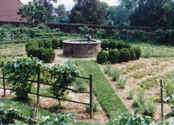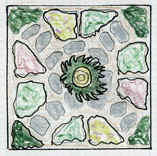Homage
to Herbs
by Paula Steers
Brown, Contributing Writer
From Shakespeare to Simon and Garfunkel, herbs have
been lauded, and the praise is not limited to parsley, sage, rosemary, and
thyme. Countless herbs are stimulating for many reasons. Practically, they
have spiced up plain foods, created soothing fragrances, and yielded
healing home remedies for centuries. Aesthetically, they provide
ornamentation in individual arrangements, in groupings of pots tucked onto
a city balcony, or in neat garden beds, small scale or large, informal to
traditional. No matter what your landscape or lifestyle, herb gardening is
immediately rewarding. Once you experience the ease yet impact of snipping
fresh oregano for your spaghetti sauce or a cooling mint sprig for a
frosty julep, you�ll never want to be without herbs again.
Culinary uses. In today�s health-conscious
world of watching cholesterol, counting carbs, and eliminating sodium,
cooking with pungent herbs offers variety and savory alternative ways to
spice up everyday fare. Be fearless about incorporating herbs in regular
meals. �Seasoned� herb growers cannot cook a chicken without filling
its cavity with a new mixture of fresh herbs. Experiment with combinations
of rosemary, sage, marjoram, curry, thyme, and even mint when cooking your
next poultry. Let all the flavors cook into the meat, then remove the
herbs before serving. Richmond herb grower Wendy McCullough recommends
boiling pork ribs along with fresh herbs to eliminate much of the fat
before grilling and reduce grilling time while imparting fantastic flavor.
Plant nasturtiums as the colonists did; pluck their
distinctive round leaves and
|

Pungent
rosemary forms a striking evergreen shrub in the front garden of
this city dweller. |
colorful blossoms to add peppery zest to fresh
salads and salsas. Freshly harvested caraway seeds cooked in rye bread or
added to warm German potato salad or cabbage create a whole new taste
sensation, compared to store-bought seeds that may have sat for months on
the grocer�s shelf. Fresh basil makes any tomato dish sing; layer it on
pizza or on garden tomato slices with fresh mozzarella sprinkled with a
light vinaigrette. Grow basil in quantity to make into a delicious pesto.
Infuse boiling water with chamomile or comfrey leaves for soothing herbal
teas. Steep oils and vinegars with tarragon, oregano, dill, or chives to
add delicate flavors to salads and sauces, or chop these herbs finely and
add to butter or cream cheese for a quick hors d�oeuvre spread. Chop
your freshly harvested herbs throughout their growing season and freeze
with water in ice cube trays to be dropped into soups throughout the
winter.
Alluring fragrance. As every homeowner trying
to sell a house knows, a prerequisite for an open house is simmering
potpourri (often cinnamon or cloves) on the stove to engender cozy
thoughts and good feelings of home. Potpourris are Nature�s air
fresheners. Try experimenting with different combinations of dried herbs
to find yourself a signature fragrance. I�ll let you in on a secret: the
key to mine is putting mint with the distinctive herb Labiatae, better
known (with its biblical connotations) as Balm of Gilead.
Aromatherapy, so popular today in spas, is nothing
new. Potent lavender and lemon verbena have been used for centuries to
freshen linens, perfume b
|

Herbs
make great subjects for horticultural themes such as this
"Celestial Garden" at Buffalo Herb Farm in Raphine. Note
the "planets" --tall heads of ornamental allium
floating, appropriately, in space! |
aths, and refresh tired spirits. Place little
aromatic bouquets in vases to give a pleasant fragrance to the kitchen,
bath, or bedroom. Once addicted to the sensual pleasure of these
good-for-you herbs, you may find yourself rubbing them for an innocent
�hit� of stimulating fragrance as the Victorians did their �tussie-mussies.�
This concept of bruising herbs to emit their aroma is the reason to plant
�carpeting herbs� such as creeping thyme in and around brick or stone
on patios where they will be tread upon, �switching� on immediate
fragrance for outdoor dining.
|

The
kitchen garden of "potager" at Mt. Vernon includes herbs
and vegetables in a pleasing yet practical design. |
Natural repellent. The strong odors of herbs
can also act as environmentally safe insect repellents. Tansy, also known
as �ant fern,� has been used for years in pantries to repel ants and
is also planted at doorways to discourage flies from entering. Deer
apparently hate the smell of lavender, whose perfume humans adore, so
plant this evergreen herb liberally if you have a deer problem. Roses and
other plants plagued by Japanese beetles benefit greatly from the
inclusion of chives in the garden. Pennyroyal, rubbed onto the skin, has
long been used as a natural repellent for mosquitoes, gnats, and chiggers.
Other properties. Native Americans and early
colonists discovered many healing
|

This
metal snail, nestled in an evergreen bed of luscious
"Archer's Gold" thyme, makes a great centerpiece. |
properties of herbs and used them as the first
medicines. �Feverfew� got its name because the herbal preparation made
from its botanical parts in correct proportions reduced fevers.
Pharmaceutical companies have become quite interested in herbal properties
and many herb-based vitamins line the shelves of today�s health food
stores. It is a good idea to let government-regulated agencies determine
what herbs are safe to be ingested, but reading the history and lore is
fun and can sometimes provide a scientific link to practical medical
application. Also, if you are interested in textiles or old-fashioned
crafts, or if you simply like the idea of using environmentally friendly
products, applying herbs as natural dyes is another fascinating field of
study.
|

Spring
festivals such as "Herbs Galore" at Maymont Park in
Richmond offer a wide variety of cultivars for both the novice and
the expert. |
Site and soil. Herbs are perfect for beginners
because they are easy to grow, although most do like a sunny, well-drained
location for best performance. A small patch of culinary herbs can easily
be tucked into an existing patio by removing a few stones and amending
that soil. Random mounds of herbs grow well spreading out onto the stone
around them and the leaves stay nice and dry on the stone. Try extending a
walkway incorporating a checkerboard pattern of alternating herbs with
bricks or pavers. If your soil is not well-drained, grow herbs in pots or
in raised beds, which can be formed into pleasing geometric shapes with
practical pathways in between. This is where the fun starts: designing
your new herb garden. Take a good look at your space, prioritize your
purposes and a �must-have� plant list, then start small � you can
always expand later.
|

Making
a sketch on graph paper helps in planning your space. Have each
small square represent a specific measurement. |
Draw your space on graph paper. If you want to carve
out only a small corner, work with small triangles and consider traffic
patterns. If you are bold enough to dig an entire circle or square as a
focal point in a traditional garden, give some consideration to a central
piece of statuary to accent the area and use large numbers of the same
herb in a circle around it. Formal gardens can be greatly enhanced with
low borders of herbs like santolina or germander. The gray foliage of
artemisia especially complements roses (my favorite is A. �Powis
Castle�). If your garden is rustic, paint an old bench with marine
sealer to waterproof as much as possible and line it with varnished bee
skeps or add some found object with character.
If you think your landscape site cannot accommodate
herbs, think again. I have
seen blacktopped parking pads removed and the
arid earth beneath transformed into lush herbal walks. If you have ever
visited Thomas Jefferson�s vegetable and herb gardens nestled into the
side of his little mountain at Monticello in Charlottesville, you can
appreciate how even a severely sloped site can be turned into a successful
kitchen garden by terracing. Cut out stepped layers of sloping earth and
amend the removed soil with peat, compost, and sand or vermiculite to
lighten soil and improve drainage. Turn pressure-treated boards on edge
and secure with stakes or construct brick or stone retaining walls to box
in the terraced beds. Replace the soil and plant these orderly spaces with
herbs and vegetables. If you have shade, you can still plant sweet
woodruff, mint-scented pennyroyal, or violets under trees as groundcovers.
Even in heavily shaded yards, you can add color and texture with angelica,
lemon balm, sweet cicely, evening primrose, valerian, ginseng, chervil,
goldenseal, lungworm, and hellebores. If you have damp areas, try
angelica, beebalm, boneset, sweet flag, elecampane, lovage, meadowsweet,
or any of the mints (mints are very invasive; consider planting in pots).
Herbs enhance. Try them � you�ll be entranced.